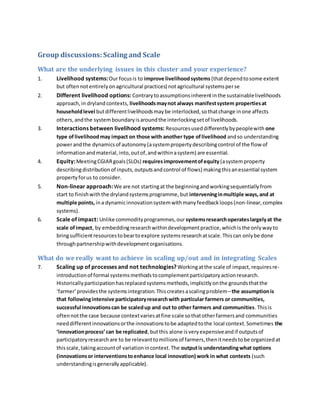
Group Discussions on Scaling and Scale
- 1. Group discussions:Scaling and Scale What are the underlying issues in this cluster and your experience? 1. Livelihood systems:Our focusis to improve livelihoodsystems (thatdependtosome extent but oftennotentirelyonagricultural practices) notagricultural systemsperse 2. Different livelihood options: Contrarytoassumptionsinherentinthe sustainablelivelihoods approach,in drylandcontexts, livelihoodsmaynot always manifestsystem propertiesat householdlevel butdifferentlivelihoodsmaybe interlocked,sothatchange inone affects others,andthe systemboundaryisaroundthe interlockingsetof livelihoods. 3. Interactions between livelihood systems: Resourcesuseddifferentlybypeoplewith one type oflivelihoodmay impact on those with another type oflivelihood andso understanding powerandthe dynamicsof autonomy(asystempropertydescribingcontrol of the flow of informationandmaterial,into,outof,andwithinasystem) are essential. 4. Equity:MeetingCGIARgoals(SLOs) requiresimprovementofequity (asystemproperty describingdistributionof inputs,outputsandcontrol of flows) makingthisanessential system propertyforus to consider. 5. Non-linear approach:We are not startingat the beginningandworkingsequentiallyfrom start to finishwiththe drylandsystemsprogramme,but interveninginmultiple ways,and at multiple points, ina dynamicinnovationsystemwithmanyfeedbackloops(non-linear,complex systems). 6. Scale of impact: Unlike commodityprogrammes,our systemsresearchoperateslargelyat the scale ofimpact, by embeddingresearchwithindevelopmentpractice,whichisthe onlywayto bringsufficientresourcestobeartoexplore systemsresearchatscale.Thiscan onlybe done throughpartnershipwithdevelopmentorganisations. What do we really want to achieve in scaling up/out and in integrating Scales 7. Scaling up of processes and not technologies?Workingatthe scale of impact, requiresre- introductionof formal systemsmethodstocomplementparticipatoryactionresearch. Historicallyparticipationhasreplacedsystemsmethods,implicitlyonthe groundsthatthe ‘farmer’providesthe systemsintegration.Thiscreatesascalingproblem–the assumptionis that followingintensive participatoryresearchwith particular farmers or communities, successful innovationscan be scaledup and out to other farmers and communities.Thisis oftennotthe case because contextvariesatfine scale sothatotherfarmersand communities needdifferentinnovationsorthe innovationstobe adaptedtothe local context.Sometimes the ‘innovationprocess’can be replicated,butthis alone isveryexpensiveandif outputsof participatoryresearchare to be relevanttomillionsof farmers,thenitneedstobe organizedat thisscale,takingaccountof variationincontext.The outputis understandingwhat options (innovationsor interventionstoenhance local innovation) work in what contexts (such understandingisgenerallyapplicable).
- 2. 8. Systems research is site specific. That is, itfocusesonimprovingsystemsinaparticular geography.While itgeneratesgenerallyapplicable understandingof whatoptionsare relevant indifferentcontextsthatcanbe scaledout(see 7),thisis achievedbottomupateach action site,ratherthantop downthroughcomparative analysisacrossactionsites.Thismeansthat globallyrelevantresultsshould be emergentpropertiesofthe research complexacross sites (thathave sufficientcommonalityof methodandreportingtoenable this),ratherthanthe subjectof a deliberative processtogeneratethem. How to go about it: Strategies and actions? 9. Scaling domain:We use the term innovationsystemtorefertothe constellationof actors (institutionsandindividuals),theirknowledge,andtheirinteractions, thatgeneratesandtests optionstoimprove livelihoodsystems.Thisleadsustodefine akeyscale of operationforthe drylandsystemsprogramme atthe administrativeunit(usuallyadistrictinAfrica, that we refer to as the scalingdomain) atwhichagricultural innovationcanoccur and can be fostered.These scalingdomainscomprise heterogeneity.We use the term, innovationplatformtorefertothe mechanismforinjectingsystemsmethodsintothe innovationsystem, whichwillrequire capacityand institutionaldevelopmentamongstactorstocope withapplicationof systems methodsatscale.Thiscan be pragmaticallyenvisionedasaco-learningcycle. 10. Operational domains: The primaryfocusof ourplace-basedresearchisthe ActionSite.This may have a numberof operational scalingdomainswithinitatwhichinnovationplatformsare established.Actionsites(transectsinWAS&DS) deliberatelycomprisearange incontext.Scaling up involvesspreadingadoptionwithinthe site,scalingoutinvolvesadoptionof outputsfromthe actionsite to relevantcontextsbeyondthe site itself. How can we harmonize the way we work at scales across the regions? 1. What scale researchshouldoperate andintegrate 2. Scalingupand out What scaleresearchshouldoperateandintegrate Variabilityinbiophysical andsocio-economicenvironments Representativenessof the targetarea or similarityof environmental units Type of intervention/process e.g.,large agro-pastoral systemsorfarms or marketchains Target an area where farmtypologyremainsconstant orecologystartschanging Numberof householdscovered Relevance tolocal conditionse.g., districtinIndiaisdifferentfromdistrictinJordan Communityscale towatershedlevel forwhichthe DSresearchisrelevant District- intermediaryscale Flagshipregion Political constituencies Scalingupand out–Actionsite Notscalingthe technologybutmethodology
- 3. Requiresconsiderationof policies,institutions Leveragingondevelopmental expenditureiscrucial toreach the targets Time and scale factors Minimumcriteriafordissemination Direct/indirectapplicabilityof solutions Domain-variesfromone innovation tothe other Create visible impacts Cost efficiency/potential forreachingtargets- essentiallyatactionsite level Scienceofscaling -Issues Probablyneedresearchonscalingstrategy? o SpatiallyexplicitIntegratedmodelsto predictimpacts o How to understandanddeal withheterogeneity? o Linkage betweenscalesforoperationalizingthe scalingup
